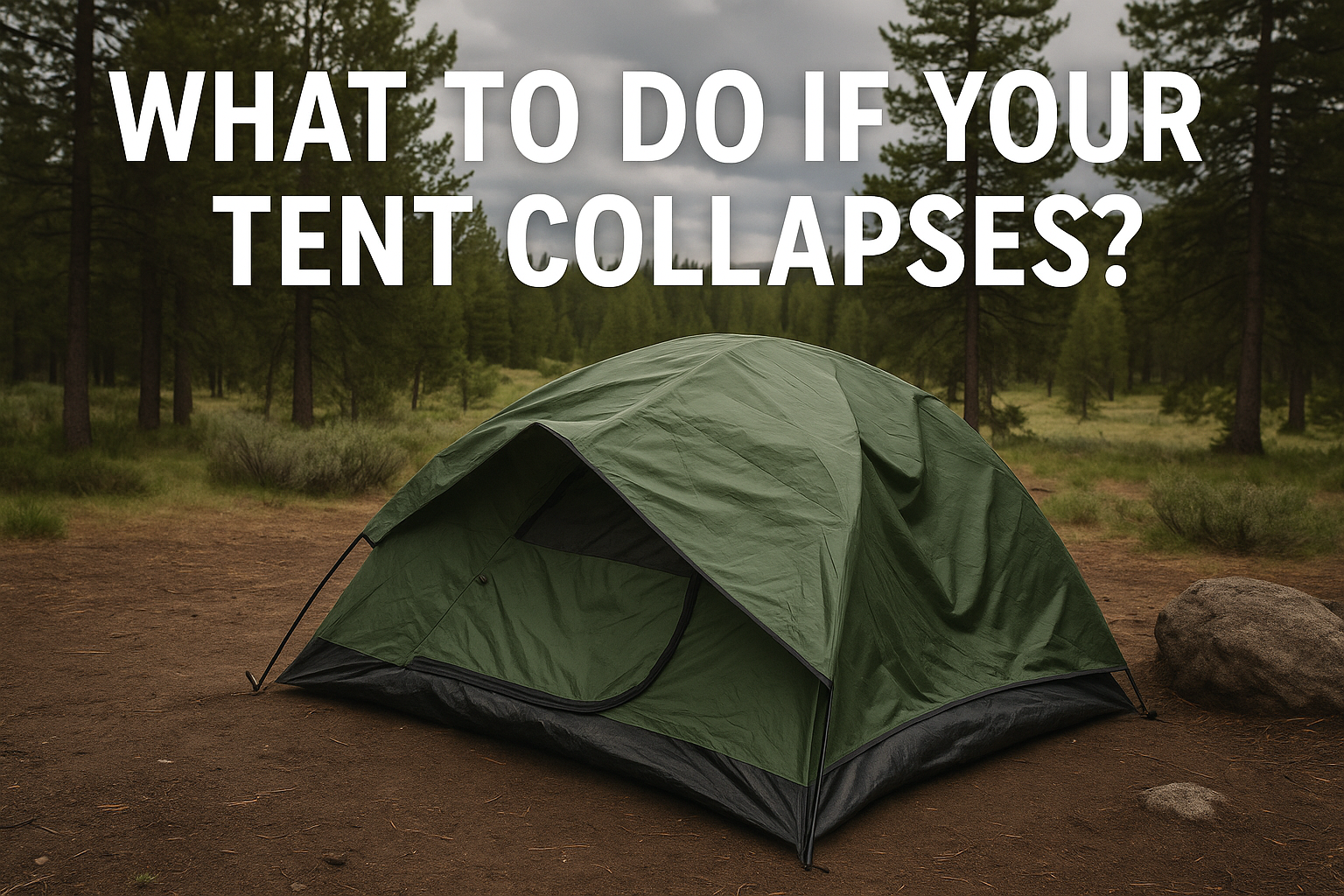You’re lying there when it happens —
the gust hits, the poles snap, the rain pours in, or a zipper rips open like a wound.
Suddenly, your “safe place” is a pile of wet nylon flapping in the dark.
First-time campers often freeze — mentally and physically — when their shelter fails.
But if you act smart, even a collapsed tent is not the end of your survival.
Here’s how to turn a disaster into a new shelter, step-by-step, even in an emergency.
1. Stay Calm — Then Immediately Move Into Action
First survival mistake:
People sit stunned inside the collapsed tent, getting wetter and colder by the second.
What to do instead:
- Get OUT of the collapse zone immediately.
- Pull your gear and bag OUT too — even if it’s raining.
- You must create a dry zone around yourself first, not later.
Why?
A collapsed tent collects water, suffocates warmth, and traps you.
Your first move is to escape and regroup with your gear intact.
The first 5 minutes after collapse decides your entire night.
2. Salvage Structural Materials (Even Broken Ones)
Your tent is broken — but its parts are not useless.
Emergency Field Tactics:
- Tent Poles:
- Even snapped poles can be lashed together with cord, duct tape, shoelaces, or strips of tent fabric.
- Broken poles = shorter support rods = perfect for building low “A-frame” shelters.
- Tent Fabric:
- Even ripped fabric is still waterproof over small areas.
- You can drape it like a tarp, patch holes with spare clothing, and layer it to block rain and wind.
Pro Tip:
Your collapsed tent is now a material kit. Not junk. Think like a builder, not a victim.
3. Deploy an Emergency “Lean-To” Shelter With Available Gear
No tent frame? No problem.
Emergency Lean-To Setup:
- One side against a windbreak: tree, large boulder, embankment.
- Stretch tent fabric across it: Use broken poles, sticks, trekking poles, or even tie it to branches.
- Weigh down edges with rocks or logs.
- Angle it steeply to shed rain fast.
What matters:
- Shelter your head and torso first — legs can handle exposure longer.
- Even a half-body shelter massively increases survival chances.
If the weather worsens:
- Dig a shallow ditch under your lean-to to divert rain runoff.
In a survival shelter, protecting your core buys you the hours needed to survive till daylight.
4. Create a “Human Burrito” With Tent Fabric and Emergency Layers
Sometimes you can’t rebuild a standing shelter at all — too dark, too windy, too dangerous.
What to do:
- Wrap yourself entirely inside tent fabric, rain fly, or ground cloth like a burrito.
- Stuff insulating materials (leaves, clothes, backpack contents) between layers if possible.
- Hunker down against a natural windbreak: tree roots, fallen logs, or even a dug-out hollow.
Why it works:
- Trapping body heat + cutting wind exposure = survival.
Micro-Hack:
Tie the bottom of the burrito with spare laces or strip of cloth to keep heat inside.
You are no longer “sleeping” — you are weathering the storm inside your portable cocoon.
5. Use the “Body Heat Amplifier” Strategy If You Have a Partner (or Gear)
If you are with a second person (or even have extra warm gear):
You must use combined body heat.
- Get inside the burrito or lean-to shelter together.
- Shared body heat can increase survival temperature by 10–20 degrees Fahrenheit compared to solo survival.
If alone:
- Stuff your sleeping bag with extra gear — jackets, backpacks, even your empty tent stuff sack filled with debris — to trap heat artificially.
In survival, insulation beats bravado. Always.
6. Prioritize Shelter Over Fire in High Wind or Wet Conditions
Common mistake first-timers make:
- Wasting time trying to start a fire while exposed to rain and wind.
Reality:
- If your tent collapses during a storm, your #1 priority is a weatherproof shelter — not fire.
Why:
- Hypothermia sets in faster when wet than when cold.
- Wind blows away small fires before they can heat anything meaningfully.
- A dry, insulated shelter traps the heat you already produce.
Field Rule:
If you can’t stay dry, you won’t live to enjoy that fire.
7. Signal for Help Using Your Tent Fabric if Necessary
Collapsed or ripped tent material is excellent high-visibility signaling gear.
How to signal if you’re in real trouble:
- Stretch tent fabric flat on open ground.
- Shape it into a giant triangle, X, or SOS — unnatural geometric shapes are easy to spot from search planes.
- Bright colors (orange, red, blue) are ideal.
Bonus survival move:
If you have a flashlight or headlamp, flash it toward any sounds, lights, or trails — movement attracts attention.
In survival, your broken tent isn’t trash — it’s your flag.
🛡 Emergency Quick Action Plan (When Your Tent Collapses)
✅ Escape the collapsed structure with your gear fast.
✅ Salvage every useful pole, rope, and fabric.
✅ Build a low lean-to or burrito yourself inside the tent fabric.
✅ Stay dry first — warmth second — fire third.
✅ Use your broken tent fabric as a last-resort rescue signal if needed.
🌄 Conclusion: Your Shelter Is What You Make It
Your first instinct will scream to panic when your tent collapses.
You’ll want to give up.
But wilderness survival isn’t about perfect conditions —
It’s about turning broken pieces into a livable world until help comes or the storm passes.
Even with broken poles, ripped fabric, and bad weather —
You can rebuild safety around you.
You can survive.
And you’ll walk out of that wild night with something no tent warranty could ever give you:
Self-trust.

